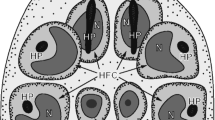Abstract
Echinococcus multilocularis oncospheres, primary vesicular cysts, and protoscolices were assessed in vitro and in vivo for their potential to synthesize a PAS-positive laminated layer containing monoclonal antibody (mAb) G11-binding Em2 antigen. The presence of Em2 antigen in developed oncospheres and cysts was subsequently correlated to the potential of in vivo development into a secondary metacestode in recipient host mice, which also responded by anti-Em2 serum antibody formation. In contrast, protoscolices failed to develop the “Em2-positive” layer in vitro under the selected experimental conditions. The failure to develop subsequently in vivo into a secondary metacestode was underlined by a lack of anti-Em2 serum antibody formation by the hosts. We furthermore developed a technique to obtainE. multilocularis clones by inoculating single oncospheres into recipient mice.
Similar content being viewed by others
References
Ali-Khan Z, Siboo R (1982)Echinococcus multiocularis: immunoglobulin and antibody response in C57BL/6J mice. Exp Parasitol 53:97–104
Al Nahhas S, Gabrion C, Walbaum S, Petavy AF (1991) In vivo cultivation ofEchinococcus multilocularis protoscolices in micropore chambers. Int J Parasitol 21:383–386
Delabre I, Gabrion C, Contat F, Petavy AF, Deblock S (1987) The susceptibility of the Mongolian gerbil (Meriones unguiculatus) and the OF1 mouse strain toEchinococcus multilocularis-ultrastructural aspects of the cysts. Int J Parasitol 17:773–780
Deplazes P, Gottstein B (1990) Genus-and species-specific monoclonal antibodies againstEchinococcus multilocularis Bull Soc Fr Parasitol 8 [Suppl 2]:912
Deplazes P, Gottstein B (1991) A monoclonal antibody againstEchinococcus multilocularis Em2 antigen. Parasitology 103:41–49
Eckert J, Pohlenz J (1976) Zur Wirkung von Mebendazol auf Metazestoden vonMesocestoides corti undEchinococcus multilocularis. Tropenmed Parasitol 27:247–262
Gottstein B (1985) Purification and characterization of a specific antigen fromEchinococcus multilocularis. Parasite Immunol 7:201–212
Hinz E (1972a) Die Aufarbeitung des Infektionsmaterials für die intraperitoneale Infektion der Maus mitEchinococcus multilocularis. Tropenmed Parasitol 23:387–390
Hinz E (1972b) Die Entwicklung des sekundärenEchinococcus multilocularis in der experimentell infizierten Maus, Eine quantitative Analyse. Tropenmed Parasitol 23:256–265
Kroeze WK, Tanner CE (1986)Echinococcus multilocularis: responses to infection in Mongolian gerbils. Exp Parasitol 61:1–9
Marchiondo AA, Andersen FL (1984) Light microscopy and scanning electron microscopy of the in vitro evagination process ofEchinococcus multilocularis protoscolices. Int J Parasitol 14:151–157
Nakao M, Nakaya K, Kutsumi H 61990) Murine model for hepatic hydatid disease without biohazard. Jpn J Parasitol 39:296–298
Rausch R, Jentoft VL (1957) Studies on the helminth fauna of Alaska. XXXI. Observations on the propagation of larvalEchinococcus multilocularis Leuckart, 1863, in vitro. J Parasitol 43:1–8
Rodriguez-Caabeiro F, Casado N (1988) Evidence of in vitro germinal layer development inEchinococcus granulosus cysts. Parasitol Res 74:558–562
Sakamoto T, Sugimura M (1970) Studies on echinococcosis. XXIII. Electron microscopical observations on histogenesis of larvalEchinococcus multilocularis. Jpn J Vet Res 18:131–144
Thompson RCA, Lymbery AJ (1990)Echinococcus: biology and strain variation. Int J Parasitol 20:457–470
Thompson RCA, Deplazes P, Eckert J (1990) Uniform strobilar development ofEchinococcus multilocularis in vitro from protoscolex to immature stages. J Parasitol 76:240–247
Vuitton DA, Guerret-Stocker S, Carbillet JP, Mantion G, Miguet JP, Grimaud JA (1986) Collagen immunotyping of the hepatic fibrosis in human alveolar echinococcosis. Z Parasitenkd 72:97–104
Yamashita J, Ohbayashi M, Sakamoto T, Orihara M (1962) Studies on echinococcosis. XIII. Observation on the vesicular development of the scolex ofE. multilocularis in vitro. Jpn J Parasitol 10:85–96
Author information
Authors and Affiliations
Additional information
This work was supported by grant 31-29651.90 from the Swiss National Science Foundation
Rights and permissions
About this article
Cite this article
Gottstein, B., Deplazes, P. & Aubert, M. Echinococcus multilocularis: immunological study on the “Em2-positive” laminated layer during in vitro and in vivo post-oncospheral and larval development. Parasitol Res 78, 291–297 (1992). https://doi.org/10.1007/BF00937086
Accepted:
Issue Date:
DOI: https://doi.org/10.1007/BF00937086




